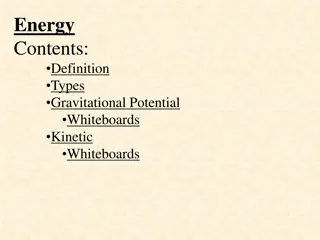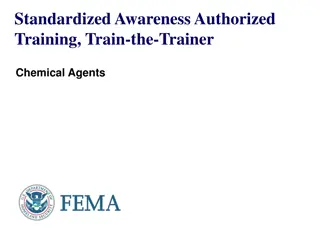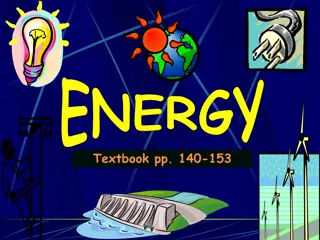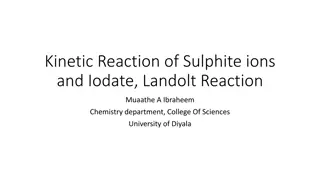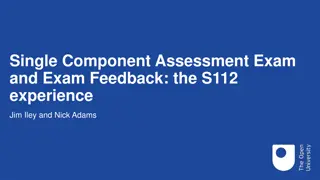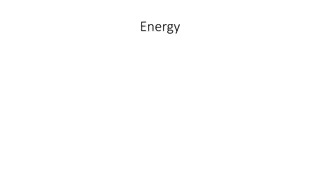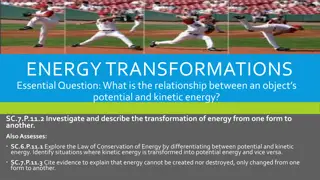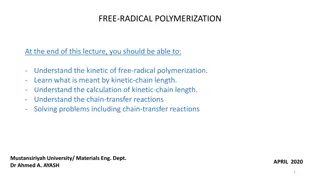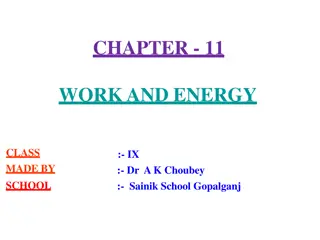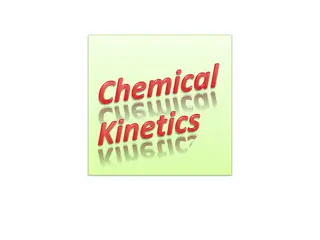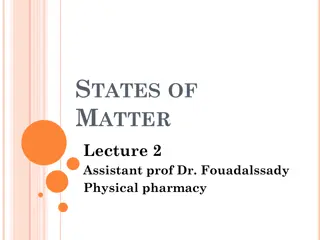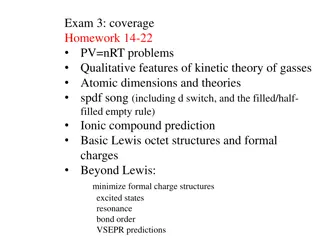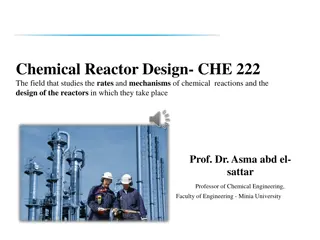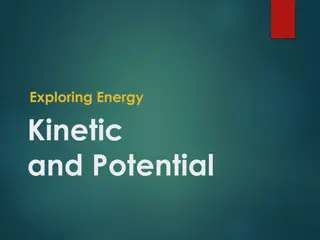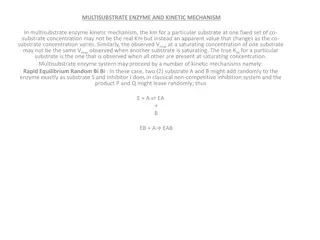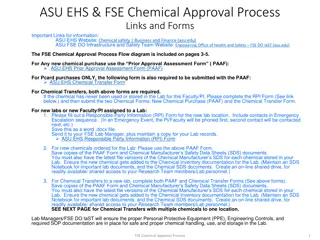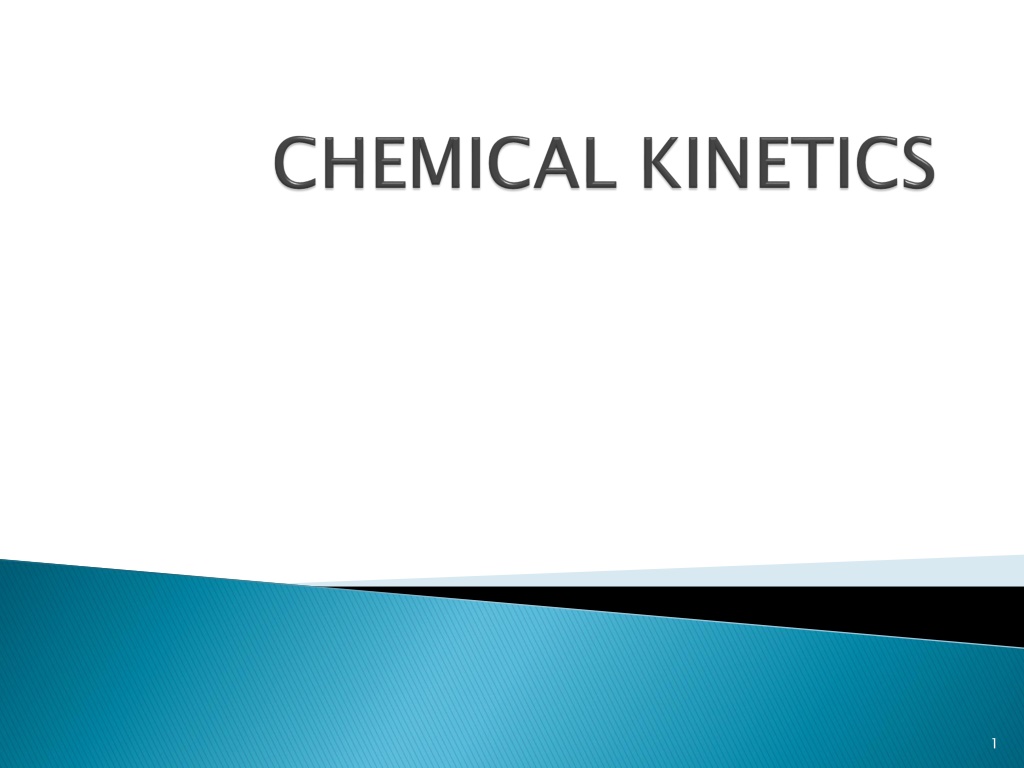
Chemical Reaction Rates and Factors Overview
Explore the concepts of slow, fast, and moderate chemical reactions, reaction rates, and stoichiometry in this comprehensive guide. Learn about reaction mechanisms, kinetics, and examples of different reaction rates. Understand the dynamics of very slow, fast, and moderate reactions with real-world examples. Delve into the factors influencing reaction rates and the study of chemical kinetics.
Download Presentation

Please find below an Image/Link to download the presentation.
The content on the website is provided AS IS for your information and personal use only. It may not be sold, licensed, or shared on other websites without obtaining consent from the author. If you encounter any issues during the download, it is possible that the publisher has removed the file from their server.
You are allowed to download the files provided on this website for personal or commercial use, subject to the condition that they are used lawfully. All files are the property of their respective owners.
The content on the website is provided AS IS for your information and personal use only. It may not be sold, licensed, or shared on other websites without obtaining consent from the author.
E N D
Presentation Transcript
INTRODUCTION EXAPMLES OF SLOW, FAST AND MODERATE REACTIONS RATE OF A CHEMICAL REACTION REACTION RATES AND STOCHIOMETRY UNIT OF RATE OF REACTION 2
Chemical the rates of chemical reactions, the factors that affect these rates, and the reaction mechanisms by which reactions occur. ( A reaction mechanism is the step by step sequence of elementary reactions by which overall chemical process occurs) Chemical kinetics kinetics is the study of 3
Some reactions can take days, weeks and months to complete; they are called very slow reactions. Milk may take several hours or a day to convert to curd Formation of crude oil by a geochemical reaction Rusting of iron Radioactive disintegration of radium. Fermentation of sugar or molasses to ethyl alcohol 4
Chemical reactions that complete in a very short time, they are called fast reactions. Magnesium ribbon is burnt in the flame of Bunsen burner, it quickly gets combusted with a noticeable spark. a neutralisation reaction between acids and bases is a fast reaction formation of silver chloride precipitate when sodium chloride solution is mixed with silver nitrate solution. 5
Moderate reactions are those reactions that take place in few minutes to few hours. Digestion of food is also a chemical reaction which takes place in several hours . Hydrolysis of an ester called methyl acetate. when methyl acetate reacts with water molecule, it is forms acetic acid and methyl alcohol. CH3COOCH3 + H2O -> CH3COOH + CH3OH 6
Let us consider simple reaction. R ------- P As the reaction proceeds, the concentration of the reactant R decreases with time and the concentration of the products P increases with time simultaneously. The rate of the reaction is defined as the change in the concentration of any reactant or product in the reaction per unit time. 7
Consider a hypothetical reaction, Let, [R]1 = initial concentration of reactant R at time t1 [R]2 = final concentration of reactant R at time t2 [P]1 = initial concentration of reactant P at time t1 [P]2 = final concentration of reactant P at time t2 t = t2 t1 = change in time [R] = [R]2 [R]1 = change in the concentration of reactants during the time interval (t2- t1) [P] = [P]2 [P]1 = change in the concentration of products during the time interval (t2- t1) R ------- P 8
Since, [R] is a negative quantity (as concentration of reactants is decreasing), it is multiplied with 1 to make the rate of the reaction a positive quantity. Average rate concentration of reactants or products and the time taken for that change to occur to express the rate at a particular moment of time we determine the instantaneous rate be determined graphically by drawing a tangent at time t on either of the curves for concentration of R and P vs time t and calculating its slope. Average rate depends upon the change in instantaneous rate . It can 10
Reaction rate has units of concentration divided by time. Since concentration is expressed in terms mol the reaction rate is mol . in gaseous reactions, when the concentration of gases is expressed in terms of their partial pressures, then the units of the rate equation will be atm mol lit lit- -1 or mol mol dm mol lit dm- -3 3 , hence the unit of lit- -1 1 s s - -1 1 or mol mol dm dm- -3 3 s s - -1 1 atm s s 1 1. 12
2NH3(g) N2(g) + 3H2(g) Rate of zero order reaction is equal to rate constant I.e. Rate = 2.5 10-4molL-1sec-1. According to rate law - d [NH3]/2dt = d [N2]/ (dt) 2.5 10-4mol L-1sec-1= d [N2]/ (dt) the rate of production of N2is 2.5 10-4mol L- 1sec-1. 14
According to rate law, - d [NH3]/2dt = d [H2]/ (3dt) d [H2]/(dt) =(-3) x d[NH3]/[2dt] i.e. rate of formation of H2is 3 times rate of reaction = 3 2.5 10-4mol L-1sec-1 = 7.5 10-4mol L-1sec-1 Rate of formation of N2and H2is 2.5 10-4mol L-1sec-1and 7.5 10-4mol L-1sec1 respectively 15

